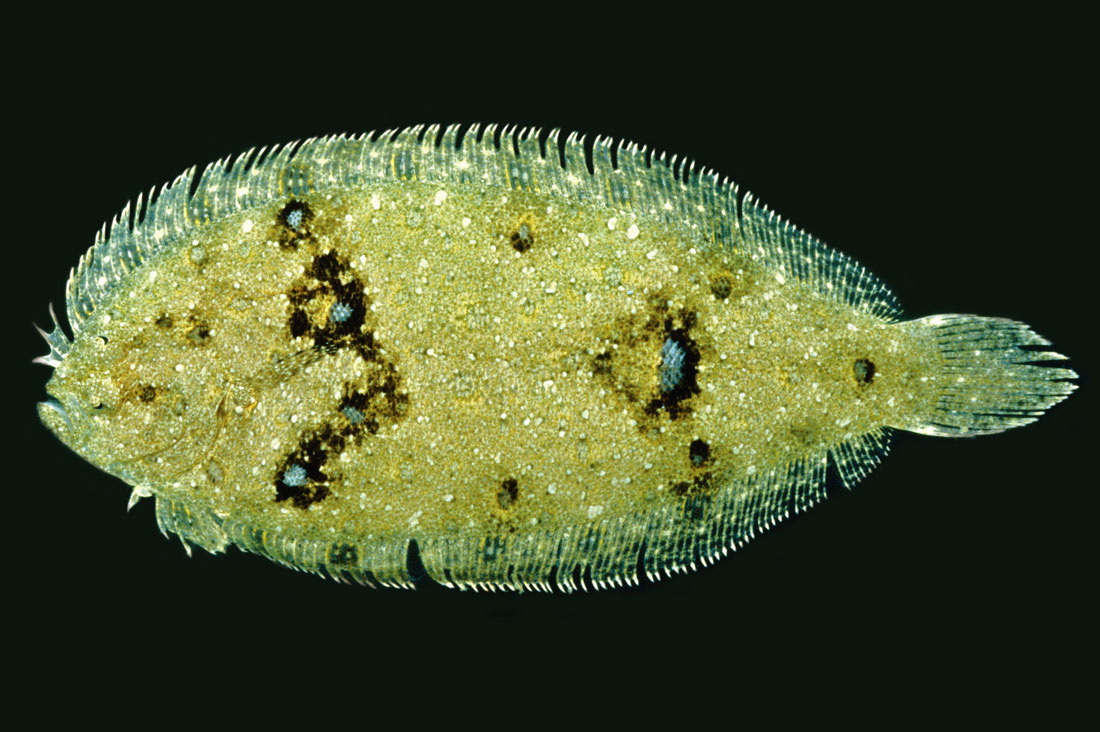Bass Strait Flounder, Arnoglossus bassensis Norman 1926

A Bass Strait Flounder, Arnoglossus bassensis, from St Leonards, Port Phillip, Victoria. Source: Rudie H. Kuiter / Aquatic Photographics. License: All rights reserved
Summary:
A brownish-grey flounder with large blackish blotches along the mid-side and near the upper and lower edges of the body, and dark spots sometimes scattered on the fins.
Cite this page as:
Bray, D.J. 2024, Arnoglossus bassensis in Fishes of Australia, accessed 27 Jun 2025, https://fishesofaustralia.net.au/home/species/938
Bass Strait Flounder, Arnoglossus bassensis Norman 1926
More Info
|
Distribution |
Endemic to southern Australia, from Narooma, New South Wales, to Spencer Gulf, South Australia, including around Tasmania. Inhabits sandy and shelly areas at depths to 70 m. |
|
Features |
Dorsal fin 96-102; Anal fin 76-80; Caudal fin 15; Pectoral fin 10; Pelvic fin 6; Lateral line scales 81-90; Gill rakers 7-8; Vertebrae 41-44. Body deep (42-46% SL), extremely compressed, of moderate length. Head small (21-24% SL); eyes on left side of head, small (15-20% HL), separated by low, narrow ridge; mouth moderately small (upper jaw length 36-40% HL), oblique; teeth small, pointed, single row in each jaw. Scales very small, weakly ctenoid on eyed side, cycloid on blind side, somewhat loosely attached, covering all of head; lateral line present only on eyed side, with prominent dorsal curve above pectoral fin, terminating anteriorly above and behind upper end of gill opening. Dorsal, anal and caudal fins separate; dorsal fin arising above anterior nostrils, without elongate anterior rays; caudal fin broadly pointed. Left pectoral fin slightly longer than right. Left pelvic fin originating at anterior extent of chest, with longer base than right. |
|
Colour |
Eyed-side brown with variable dark and pale spots and speckles, usually with large dark spots on midside. |
|
Similar Species |
Difficult to distinguish from Mueller's Flounder, Arnoglossus muelleri. Mueller's Flounder has slightly larger scales and eyes, and appears to be more common. |
|
Etymology |
The species is named bassensis for the type locality: Bass Strait. |
|
Species Citation |
Arnoglossus bassensis Norman 1926, Biological Results of the Fishing Experiments carried on by the F.I.S. Endeavour 1909-1914 5(5): 246, fig. 6. Type locality: east coast of Flinders Island, Bass Strait, Tasmania. |
|
Author |
Bray, D.J. 2024 |
|
Resources |
Bass Strait Flounder, Arnoglossus bassensis Norman 1926
References
Amaoka, K., Arai, M. & Gomon, M.F. 1997. A new species of Arnoglossus (Pleuronectiformes: Bothidae) from the southwestern coast of Australia. Ichthyological Research 44(2): 131-136 figs 1-3 https://doi.org/10.1007/BF02678692
Amaoka, K., Matsuura, K. & Carpenter, K.E. 2020. Arnoglossus bassensis. The IUCN Red List of Threatened Species 2020: e.T143819237A143844387. https://dx.doi.org/10.2305/IUCN.UK.2020-1.RLTS.T143819237A143844387.en. Accessed on 27 February 2024.
Gomon, M.F. 1994. Family Bothidae. pp. 844-850, figs 747-752 in Gomon, M.F., Glover, C.J.M. & Kuiter, R.H. (eds). The Fishes of Australia's South Coast. Adelaide : State Printer 992 pp. 810 figs.
Gomon, M.F. 2008. Family Bothidae. pp. 808-810 in Gomon, M.F., Bray, D.J. & Kuiter, R.H. (eds). Fishes of Australia's Southern Coast. Sydney : Reed New Holland 928 pp.
Kuiter, R.H. 1993. Coastal Fishes of South-eastern Australia. Bathurst : Crawford House Press 437 pp.
Last, P.R., Scott, E.O.G. & Talbot, F.H. 1983. Fishes of Tasmania. Hobart : Tasmanian Fisheries Development Authority 563 pp. figs.
Norman, J.R. 1926. A report on the flatfishes (Heterosomata) collected by the F.I.S. Endeavour, with a synopsis of the flatfishes of Australia and a revision of the subfamily Rhombosoleinae. Biological Results of the Fishing Experiments carried on by the F.I.S. Endeavour 1909-1914 5(5): 219-308 figs 1-15






